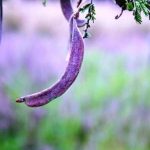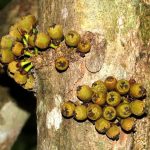TREE LIFE
November 2002
AS BEFORE PLEASE CONFIRM WITH ANY OF THE COMMITTEE MEMBERS THAT THE SCHEDULED OUTINGS AND WALKS WILL ACTUALLY TAKE PLACE. SEE THE BACK PAGE FOR PHONE NUMBERS.
MASHONALAND CALENDAR
Tuesday 5th November: Botanic Garden Walk. Meet Tom in the car park at 4.45 p.m. for 5 p.m. for the continuation of the family Leguminosae.
Sunday 17th November: This time our walk in Christon Bank will be in a different area, i.e. to the edge of the mountain range overlooking the main Mazowe Road and the Henderson Research Station. The walk will not be too strenuous with just a short section which is steepish but the pace will be as slow as you like. Jack Jaklitsch who knows the area well will lead with Mark.
As usual we will meet at 9.30 in the car park.
Saturday 23rd November: Mark’s walk is to Bill Clarke’s lovely property Val D’Or in the Arcturus area. As usual we meet at 2.30 p.m.
Tuesday 3rd December: Botanic Garden Walk.
MATABELELAND CALENDAR
All Matabeleland Branch Tree Society members are invited to the Matobo Conservation Society A.G.M. on Saturday 9th November at Camp Dwala (Stephen’s Farm, E. Matopos), the same venue as last year. We will meet at 13:15 to leave by 13:30 p.m. at the Churchill Arms car park. Lifts can be arranged.
Please provide own chairs, tables, meals and drinks. Speaker was to be Mr. A Kumirai, Director, Western Region, National Museums and Monuments.
The route from the Matobo Mission will be signposted, so folk wishing to travel out earlier and enjoy a picnic lunch will be welcome. An evening braai will once again be held, and limited overnight accommodation (including camping) will be available on a first booking basis.
We anticipate arrival at the designated site by 5:45 a.m. Sunrise is at 6:05 a.m., with the eclipse starting at about this time. The period of totality will be at approx. 8:15 a.m. lasting for 1 minute 20 seconds. On arrival, members will be able to select areas of their own choice for viewing – it is not recommended that we congregate in one large group, but spread ourselves out in the general selected area. You will be able to lay out a breakfast while enjoying the early morning. A short talk on the eclipse (what to expect and look out for, etc.) will be given at 7:00 a.m. Following 10:16 a.m. we suggest that members take a picnic lunch, and return at their leisure in the afternoon. Members wishing to travel out the day before and camp must contact the MCS Secretary. We will be joined by Wildlife and Environment Zimbabwe, and the Ornithological Society.
COMMENTS ON TREE LIFE No. 272
Jonathan Timberlake has responded to some of the articles in TREE LIFE 272 with interesting notes and observations.
Binocular Botany
“Acacia karroo was common and easily identifiable. Jonathan comments, “Undoubtedly not Acacia karroo (which does not occur at lower altitudes) but Acacia robusta ssp. clavigera. Its habit can appear similar to Acacia karroo, but it is normally taller and riverine.”
LJM comment: Jonathan is undoubtedly right, and if I had consulted maps of the natural distribution of the two species I would not have made such a positive(ly wrong) statement. From a distance, through binoculars, the pods of the two species could be confused, so perhaps I could be forgiven for the error!
“Unmistakable Terminalia fruits”
Jonathan asks “Could this be Xeroderris stuhlmannii? Usually a wide canopy.” LJM replies, Yes it could, but the tree was in full (new) leaf, and my impression was of simple, rather than compound, leaves. Unfortunately, the distance was too great to be sure one way or the other, even with the more powerful binoculars, but the canopy was wide, so it could have been Xeroderris.
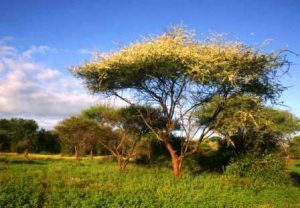
Acacia tortilis. Photo: Bart Wursten. Source: Flora of Zimbabwe
“Acacia tortilis was less common, and a little more difficult to identify except where there were a few pods remaining on the trees.” JT says “Acacia tortilis is only likely to be common there [at Kariba] on sandy alluvial deposits, old river banks, etc.” LJM replies, All the trees I identified as Acacia tortilis were on old river banks, and they definitely had tortilis pods.
Bixa
JT says “I have seen a couple of naturalized or very old established plantings at the ‘new’ campsite in the Rusitu valley, just off the main track in to the store, but a couple of bends before, as close as the track gets to the pool. Common in Mozambique as a garden plant.” LJM comment, actually there is quite a lot of it here and there in the country, and a roadside planting of it near the main entrance to Peterhouse outside Marondera.
Biblical acacias
JT wrote, “There is also Gleditsia, sometimes called Christ’s crown of thorns tree, that has spines. And Ziziphus spina-christi? Not all thorn trees from that area were acacias.” LJM comment: I think the common habit of Ziziphus spina-christi rules it out as a possible contender for the species that provided the shittim wood of Exodus, and the carob (Gleditsia triacanthos) was too well known – and too well used – in biblical times for it to be confused with the tree that provided shittim wood. By all the accounts that I have read, Acacia seyal flowers are magnificently scented, and this species would be the most likely for all biblical references to the perfume of acacias.
Guibourtia
JT writes, “Unfortunately what we knew as Calvert’s tree, the big one at around 70 km from Bulawayo, is no more. Burnt through last year and fallen.” LJM comment: I’m very sad to hear that Calvert’s Guibourtia has gone. When I last saw it three years ago it certainly had a lot of dead wood in the crown, so was probably on its way out, anyway.
-Lyn Mullin
BOTANIC GARDEN WALK: 6 JULY 2002
This was the second instalment of Tom’s discussion of the Leguminosae subfamily Papilionoideae, and I must apologise for the fact that it is appearing so long after the event. The first was written up in detail by Lyn Mullin in the August issue and a number of species were discussed on both days – but I’ll try and restrict myself to new species only.
Firstly, to add a note on the general classification. This subfamily has been split by taxonomists into “tribes”. Tribes are a taxonomic rank lower than subfamilies and higher than genera – i.e. they are generally quite large groups of genera.
An example is the tribe Dalbergieae. The Zimbabwean genera which form this tribe are: Dalbergia, Dalbergiella, Philenoptera (Lonchocarpus), Pterocarpus and Xeroderris. The species of this tribe are usually woody (trees, shrubs or climbers) and usually have flattened pods with a broad wing surrounding the seed-containing part. The leaves are usually pinnate. In other words, these genera form a reasonably similar group which is quite recognisable in the field.
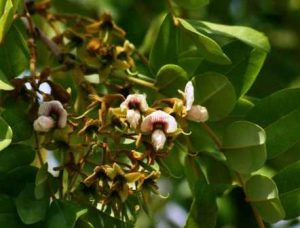
Pericopsis angolensis. Photo: Bart Wursten. Source: Flora of Zimbabwe
Another interesting feature is that the legume tribes tend to be either tropical or temperate. In Zimbabwe, we have big tribes like the Aeschynomeneae, Crotalarieae (Crotalaria), Desmodieae (Desmodium), Indigofereae (Indigofera), Phaseoleae (Eriosema, Rhynchosia and Vigna) and Tephrosieae (Tephrosia). However, if you go to the UK, you will see tribes like Fabeae (Vicia and Lathyrus), Genisteae (Lupinus, Genista and Cytisus), Trifolieae (Trifolium, Melilotus and many others). The overlap is quite limited and is mainly comprised of aliens and introductions.
In other words, both the tropical and temperate parts of the world have legumes but the tribes (and hence the genera and species) which occur in each part are quite different. The same is true of grasses and Compositae.
Sometimes the factors which unify the species in a tribe are not clear to a field botanist, but knowledge of the tribes is often quite useful. And again, this is true of the grasses and Compositae.
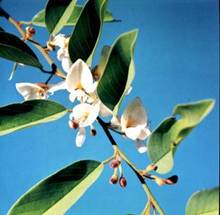
Baphia massaiensis. Photo: Bart Wursten. Source: Flora of Zimbabwe
Our first tree was Baphia massaiensis (Jasmine pea). This well-known tree occurs in sandy places. Tom explained that it occurs as an understorey shrub in the jesse and also at the edge of jesse where Julbernardia and Mufuti begin to come in. It is also extremely common on Kalahari sand.
The leaves are simple (this feature is scattered through this subfamily in a number of genera), deciduous (yellowish at this time of year) and the pods are woody. The pea flowers are white and attractive.
Tom also mentioned that in order to get this species to grow in the Botanic Gardens, it was not necessary to import tons of sand. This treatment was only necessary for the Baikiaea plurijuga.
Philenoptera nelsii (Apple-leaf lance-pod) (Lonchocarpus nelsii) was mentioned by Lyn, but just to add that this is another simple-leaved species which also occurs on Kalahari sand. Although the books say that this may have compound leaves occasionally, an examination of these two specimens failed to reveal any!
In the same genus is Philenoptera bussei (Narrow lance-pod) (formerly Lonchocarpus bussei). This has smallish leaflets and looks a little bit like another legume tree, Millettia usaramensis. Tom mentioned that it is mainly a Valley tree where it occurs along dry streams and in the jesse. The flowers are said to be a wishy-washy lilac, a bit like Bolusanthus.
On to Sophora velutina subsp. zimbabweensis. This taxon has only been found near the Great Zimbabwe ruins. It was originally named in Kirkia 5 (1966). Sophora velutina is an Asian species and in that paper, the authors speculate as to whether it is an introduction or not and if introduced, how recently. There was obviously some question as to how distinct the plant is from Asian material but in the end it was decided to describe it as a separate subspecies.
Back to the tribe Dalbergieae! Dalbergia nitidula (Purple-wood Dalbergia) is a common plant which we often see on our outings around Harare. It is a shrub, usually, sometimes a small tree and often with climbing tendencies – the ends of the branches tend to become slightly tendril-like on occasions. The leaflets are alternate and usually few, the flowers are attractive and it often bears distinctive black spiny galls. Tom mentioned that it will also tolerate chrome- and nickel-rich soils.
A much rarer species is Dalbergia boehmii (Large-leaved Dalbergia). This is a true tree and not a climber. It occurs in woodland in high rainfall areas in the Eastern Highlands.
Bolusanthus speciosus (Tree Wisteria) is a well-known and attractive species which bears lilac flowers in profusion. Its bark is rough and deeply indented. On the highveld, it occurs in heavy, black cotton soils and in the lowveld also on heavy soils. Tom made an interesting horticultural comment that the shape of this species was very variable and hence it was not really suitable as a street tree.
Finally, Ormocarpum trichocarpum (Large caterpillar pod). I must admit to having difficulties separating this from Ormocarpum kirkii (Small caterpillar pod). However, Ormocarpum trichocarpum has smaller leaflets, a calyx which is not persistent and has fruits resembling caterpillars. It occurs at medium altitudes and is common in gneiss country.
Once again, a most interesting session and our thanks go to Tom for sharing his knowledge with us.
-Mark Hyde
Two articles in Tree Life August 2002 attracted my attention
The Rain Tree
The first one was the report on the Botanic Garden walk in June 2002, and both my wife and I were shattered to learn that Lonchocarpus capassa was no more!
Having taken years to get our tongues around the name, we now have to articulate an equally unpronounceable name! Philenoptera violacea (as I must now call this tree) is a favourite of mine.
Being a beekeeper I am aware of its usefulness as a source of nectar.
In this article it is stated that this tree is often riverine. In the Matibi II Communal Area in the southeast lowveld, where the local populace relies on boreholes sunk by the previous government, it is interesting that in this flat basalt area almost all of the boreholes have sizeable rain trees growing next to them. In fact, this tree was used as an indication of potential borehole sites.
Baobabs
The second point moves once again to baobabs. Referring to the southeast lowveld, many of the larger, hollow baobabs were of importance to the local Shangaan community. Shangaan men, in lieu of being bloodied in battle, went to the mines on the Witwatersrand to achieve their manhood status. As John Wilson mentions, many of the hollows in baobabs held water and migratory labourers making their way to and from the mines used these trees as overnight stops, and as such they were well known. One such tree is on Section 2, Hippo Valley Estates, quite close to the Hippo Valley Club.
On my last trip to the Gonarezhou, I noted fresh pegs hammered into baobabs in the Pokwe Pool area to facilitate honey cropping. This, in a protected National Park, indicates a lack of control by National Park’s authorities.
There seem to be two distinct growth patterns in baobabs in the southeast lowveld. In the general area of Hippo Valley Estates/Gonarezhou, these trees have branches pointing skywards, whereas in the Save Valley travelling towards Birchenough Bridge one sees many of the baobabs with a weary-looking, drooping configuration. Again, there is a marked variation in fruit shapes.
The Buffalo-weaver nests mentioned in John Wilson’s article are, interestingly, always on the west side of the baobabs.
All in all, a most interesting tree.
-Peter Taylor
PAX PARK: 18th AUGUST 2002
A smallish group of Tree Society members met on a lovely warm winter’s morning at Pax Park, which is the Girl Guide enclave within the Lake Chivero National Park. Instead of entering the “usual” way at the bottom, we came in a back way and parked at the “top” in open Julbernardia woodland overlooking the complex of buildings. The GPS placed our altitude at 1380 m (c.4500 ft.), so definitely a little bit lower (c.100 m) than Harare.
Although this was not a day for great rarities, there was nevertheless an interesting woody flora to be seen and, despite the dryness, some non-woody plants as well. The following is a somewhat selective account of what we saw.
Rhoicissus revoilii (Warty grape) is a fairly common shrub with distinctly climbing tendencies, often occurring in rocky places. It has 3-foliolate leaves and the typical swollen nodes of the vine family, Vitaceae. The leaf margins are entire and this distinguishes it from Rhoicissus tridentata which is probably a somewhat commoner species and has toothed leaves. It was nice to see it here as a true tree, albeit a small one, with a distinct trunk and branches above.
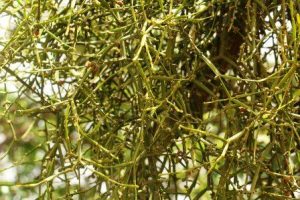
Viscum combreticola. Photo: Bart Wursten. Source: Flora of Zimbabwe
On a Combretum molle was growing a fleshy parasite (Viscum) with 4-angled stems. This I tentatively identified as Viscum combreticola. Although the name suggests that it particularly favours Combretum, which I think it does, it also occurs on other species, for example, on Burkea africana.
Another climber, which we have seen before at Pax Park, is Ipomoea verbascoidea. There is not much to see at this time of the year, no leaves and just bare stems, except for the seeds, which have an amazing coat of long hairs. The seeds persist on the plant, spilling out of the capsules, and are most noticeable.
Typical of this stage of the season, namely early Spring, there was a Dombeya rotundifolia (Wild pear) in full (white) flower, a beautiful site against the blue skies. Surely a good plant for a garden? Although a critic might comment that its flowers do tend to go rather brown and persist on the tree. Also nearby was a Diplorhynchus condylocarpon (Wild rubber) with its opposite leaves and milky juice. Also in this area were the two large-fruited, common species of Strychnos, namely Strychnos cocculoides and Strychnos spinosa.
At this point, your Chairman, stepping carelessly backwards from viewing a Burkea africana, fell into a hole and was promptly photographed by Maureen for the Society’s scrapbook.
In a rockier area, we found Maytenus undata (Koko tree). This species lacks spines and after the recent taxonomic revision of this genus remains in Maytenus and has not gone to Gymnosporia. Apart from its characteristic smell of kitchen shelf paper (or alternatively the Haxens’ wedding cake several months after the wedding!), it also has the distinctive feature that if you fold a leaf in half and then open it out there is a broad grey line along the fold. It seems that this is produced from a waxy covering on the leaf surface. The only other species I know which does this is Scolopia zeyheri (Thorn pear); however, I expect there are others and since this is a useful character, it may be worth recording in future.
After a time, we descended through larger rocks into a natural amphitheatre where there were some very fine Mountain acacias (Brachystegia glaucescens). In the understorey was a Commiphora. It is of course a feature of that genus that they are often to be found without leaves and can pose some difficulties in identification; the bark is helpful but can be variable in some species, particularly Commiphora mollis (Soft-leaved Commiphora). After some thought, and on discovering that the slash produced milk, we decided that this was what it was.
Another nice species of rocky places is Rothmannia fischeri (Woodland Rothmannia), which was found by Rob Burrett. This is a Rubiaceae and has the usual opposite (or whorled) leaves with interpetiolar stipules. A particular feature is the prominent domatia, which are tufts of hairs in the axils of the main veins beneath and which are said to house mites. These appear as small raised domes on the upper side of the leaf.
In front of Bay’s Cottage were another species of Commiphora and Margaritaria discoidea. The Commiphora was the very striking Commiphora marlothii (Paper-bark Commiphora) with its large, coarse pinnate leaves and its absolutely distinctive smooth green trunk from which large pieces of papery pale bark peel.
Finally, amongst further rocks we found what was probably a third species of Commiphora. Again, it was leafless but the green trunk implied Commiphora africana.
After lunch, a smaller party did a walk amongst some low rocky kopjes. We were led by Rob Burrett, who showed us some magnificent kudu paintings. All in all, a very enjoyable day “in the bush”.
-Mark Hyde
In Retrospect, Lyn Mullin
A CURE FOR FEVERS
In a report on an outing to Mtepatepa, published in TREE LIFE No. 135 (May 1991), Cheryl and Phil Haxen mentioned seeing “a sizeable Crossopteryx febrifuga (Crystal Bark)”, which arrested the attention of the Tree Society party.
[Comment 2000: This species was well known to David Livingstone in the mid-19th century, and he indicated in his writings that he used it for treating fevers. He also noted that the wood was very bitter to the taste, “resembling the cinchona tree (quinine) very much”. Experience of the wood in Zimbabwe is that it is surprisingly hard and heavy – about the same density as Zambezi teak (Baikiaea plurijuga) – and even the sapwood is seldom attacked by borers, termites, or fungi. Perhaps they are no more partial to chewing quinine than we are!!]
BOTANIC GARDEN WALK: 7 SEPTEMBER 2002
As Tom was away in Europe, this Saturday morning walk was led by Meg Coates-Palgrave, who very kindly stepped in to talk about riverine trees.
Meg defined three groups of plants:
hydrophytes: these actually grow in the water
rheophytes: grow by fast-running streams and flash-flood areas
riparian: these grow on the bank
Meg also observed that the band of trees by a river often corresponds with the limit of infrequent flash floods. Furthermore, the building of a dam is an event of great significance for the river below because it removes the possibility of flash floods occurring (and therefore may have an adverse effect on the band of riverine vegetation).
We then walked through the Gardens and discussed various specifically riverine species.
The first riverine species was Rhus quartiniana. This well-known plant grows in river beds, but in places which are dry (or with a little seepage of water) for much of the time. Only in seasons of flood does it actually grow in the water. This situation is typical of many of our plants and these are known as facultative rheophytes.
“Facultative” means a plant which can grow under more than one set of conditions; i.e. it can be in a dry sandy river bed one minute and flooded the next.
Syzygium guineense subsp. barotsense. This is the small-leaved taxon with a pale bark and even paler twigs which is such a prominent feature at the edge of the Zambezi River above the Victoria Falls. However, in Meg’s opinion it is not confined to there but also occurs more widely, for example by the Manyame River, below Darwendale, by the Save River and in South Africa.
Syzygium “intermedium”. What is the name of the taxon found on river banks which appears to be intermediate between Syzygium cordatum and Syzygium guineense? Typically, it has leaves with a cordate base (like cordatum) but they are also distinctly shortly petiolate (unlike cordatum). F. White decided that it was probably a hybrid between Syzygium cordatum and Syzygium guineense, but some would say that it represents a good species in its own right. The taxonomy of Syzygium is still not really “finalised”.
Phoenix reclinata is a very characteristic species of riversides. An interesting pointer is that its leaflets “make valleys” whereas those of other pinnate palms “make roofs”. Another riverine palm is Hyphaene petersiana, which leads to the next question: how many species of Hyphaene are now recognised as occurring in Zimbabwe? Meg believes that there is only one and that true Hyphaene coriacea is strictly coastal.
Ficus capreifolia (Riverine sandpaper fig) is very much a riverine species forming thickets fringing rivers. Rauvolfia caffra is also commonly riverine with narrow leaves bunched at the apex of the branches. The similar-looking Breonadia salicina (Matumi) occurs in wetter situations than Rauvolfia, often amongst rocks right by, or even in, the river bed.
Nuxia oppositifolia (River Nuxia) is another characteristic riverine species, usually occurring among rocks in the river, and is a true rheophyte. Meg noted that the leaves may be either serrate or entire; there is considerable variability in the degree of serration.
Combretum erythrophyllum is a common riverine species. The bark on larger trees is often scarred and the scars may become elongated, looking as if a cat has scratched its claws on the trunk. Euclea schimperi has distinctive glossy leaves. For the new edition of “Coates Palgrave” this has returned to specific rank from being Euclea racemosa subsp. schimperi. Meg has treated Euclea racemosa as a purely coastal species.
Acokanthera rotundata (Bushman arrow poison) is another riverine species with stiff, sharply-pointed leaves. Tom is apparently very proud of the fact that he has eaten the dried fruits! And survived.
Our thanks go to Meg for giving up her time to lead such a stimulating and interesting walk.
-Mark Hyde
IRVINE’S GAME PARK – 16 SEPTEMBER 2002
A small group of 13 spent the day in the Irvine’s private game park along the Beatrice road. It was a pleasure to drive through the well laid out and maintained farm complex before arriving at the game park gate. John and Dagmar led the short convoy on a splendid game viewing drive before we found the pavilion which was to be our base. After the lottery draw we set off without our usual leaders, on what might have been a rather aimless wander in the woodland. In fact, with input from all members of the group we got by pretty well.
Many of the trees were leafless and some were just coming into flower. The Erythrina were near the end of their flowering period and posed the usual question – Erythrina abyssinica or Erythrina latissima. We decided on Erythrina abyssinica because the anthers remained inside the flower. We noticed that the flowering stalks of Lannea discolor and Burkea africana are superficially similar. However, the Burkea flower stems seem to dangle gracefully while those of Lannea are mainly rigidly straight. Pterocarpus angolensis in bud promised a spectacular show in a couple of days, but from memory I think Pterocarpus rotundifolius will need a shower off rain to trigger its flowering instinct.
Our walk took us along the banks of a small stream, rather dry at this time of year, and across it into a woodland dotted with termitaria with the usual rich variety of plants. We recognized Ziziphus mucronata, Schotia brachypetala, Crocoxylon transvaalense, (was Cassine), Carissa edulis, Clerodendrum glabrum, Euclea divinorum, Pappea capensis, Boscia salicifolia, Strychnos potatorum and a puzzle with a distinct Flacourtiaceae look about it but no thorns!
There was plenty of evidence of grazing by the game. Many Gardenia volkensii were eaten right down to twiggy stumps, but others left untouched – why?
Carissa edulis of the notoriously toxic family Apocynaceae, was also heavily grazed. John explained that animals nibbling at poisonous plants such as Carissa could develop an immunity to the toxic substances.
Two acacias were seen. After much discussion it was decided that the large tree with straight thorns, whose leaves were out of reach was Acacia sieberiana, even though there was no paper bark even on the newer branches. Unfortunately, all but one very poor specimen of the fallen pods had been eaten.
The other was Acacia karroo, some of which, together with other trees in the woodland, were afflicted with suppurating wounds. What caused these weeping sores, and what worm or beetle manufactures the frass woven with strong web into loose ropes? Several patches of this frass was seen on the trees and also on the ground where it had fallen. It seems that little damage is done to the tree because the bug doesn’t bore very deeply into the trunk. Perhaps some of these questions will be answered when we return in December.
Lunch on the lawn at the pavilion was followed by another short stroll where, close by, the giraffe, sable, blesbok and guineafowl took little notice of us. The massive woody parts of the suffrutex Parinari capensis, which are usually underground, were exposed on a rocky patch – evidence of soil erosion perhaps.
The ground in this part of the park was littered with the pods of Combretum zeyheri, but most of the seed had been parasitized.
Then home after just one more game drive, this time seeing waterbuck, impala, kudu, and zebra. The whole scene was just perfect with suitable background noises from grey louries, a hornbill, doves and the odd protesting screech from a monkey.
We thank the Irvine family for allowing us to spend a relaxing day in their beautiful park and Eva for arranging the outing.
-Maureen Silva-Jones
ROOT NOTE: PARASITES “CHILL OUT”
In Tree Life 271 of September 2002, Maureen Silva-Jones quoted a report from the BBC Wildlife Magazine that the leaves of mistletoes on a warm summer’s day are cooler than those of the host. On the walk in the Botanic Garden on 7th September, we came across a “Loranthus” parasitising a tree and were able to reach and feel its leaves. We are able to report that this is true and that the difference is surprisingly great – the parasite’s leaves do feel very noticeably cooler.
-Mark Hyde
MARK HYDE, CHAIRMAN


